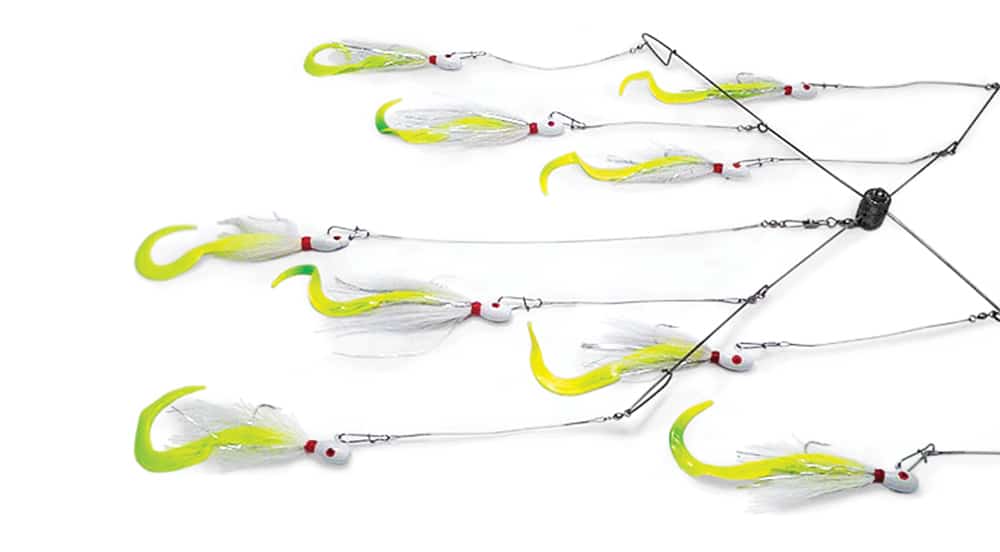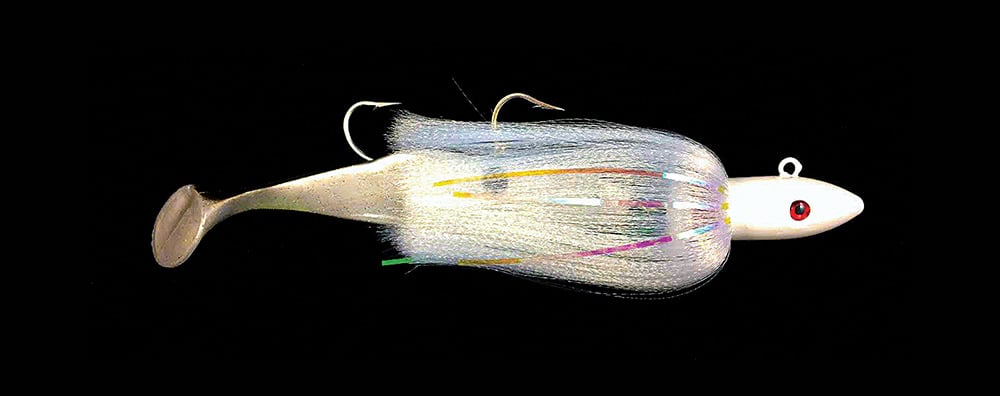The best rigs for striped bass are the ones that work in a given situation. But situations are seldom the same day to day, and location to location. When stripers are feeding at the surface any variety of plugs, spoons and jigs will garner their share of strikes. But as an overall strategy, trolling remains the premier tactic for locating and catching striped bass, and few strategies remain as consistent as the legacy umbrella rig or increasingly popular mojo rig.
Striped Bass Umbrella Rigs
One of the venerable trolling rigs for striper fishing remains the striped bass umbrella rig.
Once universal, the umbrella rig still remains popular in some locales, and it still produces fish.
The umbrella rig is an array of hookless teasers, from four to a dozen, depending on the size of the rig, trailing from a set of wire crossbars, with a hook bait rigged to follow just behind the teasers. The teasers, usually soft plastic fish imitations, or plastic paddletails, create the illusion of a school of bait. Spoons or tube lures may also be employed as the teasers.

The hookbait, which runs on a leader from the center of the crossbar, is often a soft plastic shad, or similar lure, with a parachute–a bundle of nylon fibers that enfold the lure when trolled-affixed to the front end.
The hookbait is routinely larger than the teasers, to present the illusion of a larger fish in pursuit of a school of smaller ones. For school-sized stripers, 4-inch teasers and a 6-inch hookbait are a common configuration. For larger stripers, step up the size to 6-inch teasers and a 9-inch hookbait.
The entire rig is trolled at a depth determined by trolling speed, the weight on the junction of the crossbars, or in some cases, by deployment on a downrigger. Running depth is adjusted to that of striped bass identified on sonar, or to prospect suitable bottom structure that bass hold on.
Like other trolling rigs for striped bass, striped bass umbrella rigs allow the angler to cover a lot of ground, at the desired depth, to locate and entice stripers when they may not be showing on the surface.
Striped Bass Mojo Rigs
Far simpler to manage, and in the opinion of many striper anglers more effective, the mojo jig has moved out of its original home waters of Chesapeake Bay to dominate the Atlantic coast as the go-to striped bass trolling rig.

The mojo is essentially a bucktail jig, modified and much larger than traditional casting bucktails.
Small mojos weigh in at 6 or eight ounces, and in deep water a 32-ounce head is not unusual. The lead head is dressed with a nylon skirt, affixed to the neck of the jig with the long fibers pointing forward, parachute style. When deployed, the fibers fold back over the body of the jig to expose the head and veil the body. As a rule, a large paddle-tail plastic swimbait is threaded on the jig hook. Colors range from chartreuse to natural tones such as shad.
Mojo rigs may be trolled as singles, bumped along the bottom or slight above, but more commonly are rigged and trolled tandem. A common rig consists of a heavy jig (20 to 32 ounces) on 4 feet of 60 to 80- pound leader tied to a 3-way swivel. A lighter mojo, on 6 to 8 feet of leader, is tied to the second leg of the swivel, and the third leg attaches to the main line.
The entire rig, to be trolled at 3 or 4 knots, is dropped back and allowed to sink until it hits bottom then wound up three or four turns of the reel handle to run above any bottom obstructions. Both jig size and trolling speed are adjusted to suit the depth of the water.









